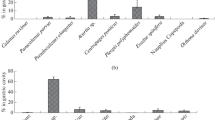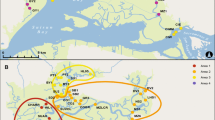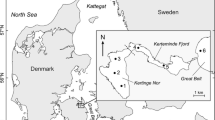Abstract
The population dynamics, ammonia and inorganic phosphate excretion, and nutrient regeneration of the common jellyfish Aurelia aurita was investigated from 1982 to 1984 in the Kiel Bight, western Baltic Sea. During summer 1982, medusae abundance ranged between 14 and 23 individuals 100 m-3, biomass was estimated at about 5 g C 100 m-3 and the mean final diameter of individuals was 22 cm. Abundance, based on numbers, in 1983 and 1984 was an order of magnitude lower; biomass was less than 2 g C 100 m-3 and jellyfish grew to 30 cm. During the summers of 1983 and 1984, A. aurita biomass constituted roughly 40% of that of the total zooplankton>200 μm. In 1982, for which zooplankton data were lacking, it was assumed that medusae biomass was greater than that of all other zooplankton groups. Total ammonia excretion ranged between 6.5 and 36 μmol h-1 individual-1, whereas inorganic phosphate release was 1.4 to 5.7 μmol h-1 individual-1. Allometric equations were calculated and exponents of 0.93 for NH4−N release and 0.87 for PO4−P excretion were determined. Nitrogen and phosphorus turnover rates were 5.4 and 14.6% d-1, respectively. In 1982, the medusae population released 1 100 μmol NH4−N m-2 d-1, about 11% of the nitrogen requirements of the phytoplankton. The inorganic phosphate excretion (150 μmol m-2 d-1) sustained 23% of the nutrient demands of the primary producers. In the other two years the nutrient cycling of the medusae was much less important, and satisfied only 3 to 6% of the nutrient demands. It is suggested that in some years A. aurita is the second most important source of regenerated nutrients in Kiel Bight, next to sediment.
Similar content being viewed by others
Literature cited
Båmstedt, U. (1985). Seasonal excretion rates of macrozooplankton from the Swedish west coast. Limnol. Oceanogr. 30: 607–617
Biggs, D. C. (1977). Respiration and ammonium excretion by open ocean gelatinous zooplankton. Limnol. Oceanogr. 22: 108–117
Cronin, L. E., Daiber, C., Hulbert, E. M. (1962). Quantitative seasonal aspects of zooplankton in the Delaware River Estuary. Chesapeake Sci. 3: 63–93
David, H. A., Hartley, H. O., Pearson, E. S. (1954). The distribution of the ratio, in a single normal sample, of range to standard deviation. Biometrika 41: 482–493
Deason, E. E., Smayda, T. J. (1982). Ctenophore-zooplankton-phytoplankton interactions in Narragansett Bay, Rhode Island, USA, during 1972–1977. J. Plankton Res. 4: 203–217
Feigenbaum, D., Kelly, M. (1984). Changes in the lower Chesapeake Bay food chain in presence of the sea nettle Chrysaora quinquecirrha (Scyphomedusae). Mar. Ecol. Prog. Ser. 19: 39–47
Grasshoff, K. (1976). Methods of seawater analysis. Verlag Chemie, Weinheim
Hamner, W. M., Jenssen, R. M. (1974). Growth, degrowth, and irreversible cell differentiation in Aurelia aurita. Am. Zool. 14: 833–849
Herman, S. S., Mihursky, J. A., McErlean, A. J. (1968). Zooplankton and environmental characteristics of the Patuxent River Estuary 1963–1965. Chesapeake Sci. 9: 67–82
Hernroth, L., Gröndahl, F. (1985). On the biology of Aurelia aurita (L.) 3. Predation by Coryphella verrucosa (Gastropoda, Opisthobranchia), a major factor regulating the development of Aurelia populations in the Gullmar Fjord, Western Sweden. Ophelia 24: 37–45
Ikeda, T. (1974). Nutritional ecology of marine zooplankton. Mem. Fac. Fish. Hokkaido Univ. 22: 1–97
Ikeda, T. (1977). The effect of laboratory conditions on the extrapolation of experimental measurements to the ecology of marine zooplankton. IV. Changes in respiration and excretion rates of boreal zooplankton species maintained under fed and starved conditions. Mar. Biol. 41: 241–252
Ikeda, T. (1985). Metabolic rates of epipelagic marine zooplankton as a function of body mass and temperature. Mar. Biol. 85: 1–11
Ikeda, T., Bruce, B. (1986). Metabolic activity and elemental composition of Krill and other zooplankton from Prydz Bay, Antarctica, during early summer (November–December). Mar. Biol. 92: 545–555
Ikeda, T., Mitchell, A. W. (1982). Oxygen uptake, ammonia excretion and phosphate excretion by krill and other antarctic zooplankton in relation to their body size and chemical composition. Mar. Biol. 71: 283–298
Jawed, M. (1973). Ammonia excretion by zooplankton and its significance to primary productivity during summer. Mar. Biol. 23: 115–120
Kerstan, M. (1977). Untersuchungen zur Nahrungsökologic von Aurelia aurita Lam. Master thesis. Kiel University
Kremer, P. (1976). Excretion and body composition of the ctenophore Mnemiopsis leidyi (A. Agassiz): comparisons and consequences. Proc 10th Eur. mar. Biol. Symp. 2: 351–362 [Persoone, G., Jaspers, F. (eds.) Universa Press, Wetteren, Belgium]
Kremer, P. (1977). Respiration and excretion by the ctenophore Mnemiopsis leidyi. Mar. Biol. 44: 43–50
Kremer, P. (1982). Effect of food availability on the metabolism of the ctenophore Mnemiopsis mccradyi. Mar. Biol. 71: 149–156
Kremer, P., Canino, M. F., Gilmer, R. W. (1986). Metabolism of epipelagic tropical ctenophores. Mar. Biol. 90: 403–412
Krüger, F. (1968). Stoffwechsel und Wachstum bei Scphomedusen. Helgoländer wiss. Meeresunters. 18: 367–383
Kuz'micheva, V. T. (1980). Uroven' dykhaniya meduz chenogo moria. In: Vinogradov, M. E., Heerkloss, R. (eds.) Bioproduktivität des Pelagials im Schwarzen Meer. Wilhelm Pieck University, Rostock, p. 91–94
Lindahl, O., Hernroth, L. (1983). Phyto-zooplankton community in coastal waters of Western Sweden — an ecosystem out of balance? Mar. Ecol. Prog. Ser. 10: 119–126
Möller, H. (1978). Significance of coelenterates in relation to other plankton organisms. Meeresforsch. Rep. mar. Res. 27: 1–18
Möller, H. (1980a). A summer survey of large zooplankton, particularly seyphomedusae, in North Sea and Baltic. Meeresforsch. Rep. mar. Res. 28: 61–68
Möller, H. (1980b). Population dynamics of Aurelia aurita medusae in Kiel Bight, Germany (FRG). Mar. Biol. 60: 123–128
Muscatine, L., Marian, R. E. (1982). Dissolved inorganic nitrogen flux in symbiotic and nonsymbiotic medusae. Limnol. Oceanogr. 27: 910–917
Phillipson, J. (1981). Bioenergetic options and phylogeny. In: Towsend, C. P., Calow, P. (eds.) Physiological ecology: an evolutionary approach to resource use. Blackwell Scientific Publications, London, p. 20–45
Pollehne, F. (1986). Benthic nutrient regeneration processes in different sediment types of Kiel Bight. Ophelia 26: 359–368
Prosser, C. L. (1973). Comparative animal physiology. 3rd ed. W. B. Saunders & Co., Philadelphia
Purcell, J. E. (1985). Predation on fish eggs and larvae by pelagic cnidarians and ctenophores. Bull. mar. Sci. 37: 739–755
Raymont, J. E. G. (1983). Plankton and productivity in the oceans. 2nd ed. Pergamon Press, Oxford
Redfield, A. C., Ketchum, B. H., Richards, F. A. (1963). The influence of organisms on the composition of sea-water. In: Hill, M. N. (ed.) The sea. Vol. 2. Wiley & Sons, New York, p. 26–77
Sage, L. E., Herman, S. S. (1972). Zooplankton of the Sandy Hook Bay area, N. J. Chesapeake Sci. 13: 29–38
Schneider, G. (1985). Zur ökologischen Rolle der Ohrenqualle (Aurelia aurita Lam.) im Pelagial der Kieler Bucht. Ph. D. thesis. Kiel University
Schneider, G. (1988a). Chemische Zusammensetzung und Biomasseparameter der Ohrenqualle Aurelia aurita. Helgoländer Meeresunters: 42: 319–327
Schneider, G. (1988b). Larvae production of the common jellyfish Aurelia aurita in the Western Baltic 1982–1984. Kieler Meeresforsch. (Sonderh.) 6:
Shenker, M. J. (1984). Scypomedusae in surface waters near the Oregon coast, May–August, 1981. Estuar., cstl. Shelf Sci. 19: 619–632
Shushkina, E. A., Musayeva, E. I. (1983). The role of jellyfish in the energy system of Black Sea plankton community. Oceanology, Wash. 23: 92–96
Smetacek, V., Dawson, R., Pollehne, F., Bodungen, B. von, Bölter, M., von Bröckel, K., Knoppers, B., Liebezeit, G., Martens, B., Peinert, R., Stegmann, P., Wolter, K., Zeitzschel, B. (1987). The pelagic system. In: Rumohr, H., Walger, E., Zeitzschel, B. (eds.) Seawater — sediment interactions in coastal waters. Springer Verlag, Berlin, p. 32–68
Smetacek, V., Bodungen, B. von, Knoppers, B., Peinert, R., Pollehne, F., Stegmann, P., Zeitzschel, B (1984). Seasonal stages characterizing the annual cycle of an inshore pelagic system. Rapp. P.-v. Réun. Cons. perm. int. Explor. Mer. 183: 126–135
Stoecker, D. K., Michaels, E., Davis, L. (1987). Grazing by the jellyfish, Aurelia aurita, on microzooplankton. J. Plankton Res. 9: 901–915
Thiel, H. (1962). Untersuchungen über die Strobilisation von Aurelia aurita Lam. an einer Population der Kieler Förde. Kieler Meeresforsch. 13: 198–230
Thill, H. (1937). Beiträge zur Kenntnis der Aurelia aurita (L.). Z. wiss. Zool. 150:51–97
Veer, H. W., van der, Oorthuysen, W. (1985). Abundance, growth and food demand of the scyphomedusa Aurelia aurita in the Western Wadden Sea. Neth. J. Sea Res. 19: 38–44
Veer, H. W., van der, Sadée, C. F. M. (1984). Seasonal occurrence of the ctenophore Pleurobrachia pileus in the western Dutch Wadden Sea. Mar. Biol. 79:219–227
Vidal, J., Whitledge, T. E. (1982). Rates of metabolism of planktonic crustaceans as related to body weight and temperature of habitat. J. Plankton Res. 4: 77–84
Weisse, T. (1985). Die Biomasse und Stoffwechselaktivität des Mikro- und Mesozooplanktons in der Ostsee. Ber. Inst. MeeresKde Kiel 144
Williams, R. B., Murdoch, M. B., Thomas, L. K. (1968). Standing crop and importance of zooplankton in a system of shallow estuaries. Chesapeake Sci. 9: 42–51
Author information
Authors and Affiliations
Additional information
Communicated by O. Kinne, Oldendorf/Luhe
Rights and permissions
About this article
Cite this article
Schneider, G. The common jellyfish Aurelia aurita: standing stock, excretion and nutrient regeneration in the Kiel Bight, Western Baltic. Mar. Biol. 100, 507–514 (1989). https://doi.org/10.1007/BF00394827
Accepted:
Issue Date:
DOI: https://doi.org/10.1007/BF00394827




